Public Pier — No Fishing License Required
I guess I should have a T-shirt for this pier that would say, “I Was There On Opening Day — 1977.” But it really doesn’t seem like a big deal today. What is relevant is that I fished three hours and caught six fish; five blackperch and one pileperch. Not great but not bad. A few days later I revisited the pier; I caught only two walleye surfperch and one starry flounder. Again, not too great. Most days at this pier are like that, rarely great fishing but usually at least a few fish. It is a very well designed pier and sits in a very attractive location.
The pier itself is only a small part of the larger Point Pinole Regional Shoreline Park. Here, in a setting of 2,147 acres, you will find a wide range of activities and ecological environments. Along the bay is a rocky, driftwood-littered shoreline. To the east is the Whittell Marsh area, a salt marsh more reminiscent of former times on the bay. Near the pier is a large blue gum eucalyptus forest, planted by the Hercules Powder Plant, the former owner of this peninsula. Why planted? As a shield for the bunkers where explosives were manufactured. Grassland areas contain native grasses such as “needle grass” and are great places for a short hike. Last but not least is the 1,225 foot-long pier which extends out into a deep water channel.
Environment. A mostly mud bottom which is normal in this part of San Pablo Bay. The shoreline is rocky and culminates in the point for which the park is named. (Which seems ideal conditions for jacksmelt.) The pilings themselves are concrete with little growth but off to the right of the pier are a number of older dilapidated pilings which will attract perch in the winter and spring, although admittedly only the inshore pilings are within casting distance. Water here can be more brackish than farther south and the point extends out into water which is crossed by several species of anadromous fish as they journey to and from the ocean and the inland rivers. Thus, here you can see such anadromous fish as king salmon, steelhead trout, striped bass, shad, white sturgeon and even green sturgeon. All of these may be caught as they cross the area but only the striped bass and sturgeon are caught in an appreciable number. More common are the white croaker (kingfish), perch, flounder, sole, jacksmelt, topsmelt, skates, sharks and bat rays.
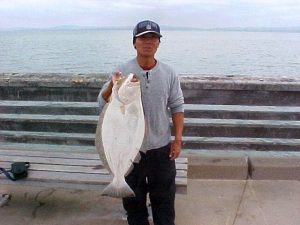
California Halibut caught by “Stan The Man”
Fishing Tips. The majority of fishing effort (and success) centers on white croaker (kingfish), jacksmelt, sharks, perch and striped bass. The kingfish prefer a small piece of anchovy for bait although they’ll also hit pieces of squid and pile worms. Use a high/low leader with a number 4 hook and be prepared for quick action since the kingfish will often hit a bait as it settles toward the bottom. It’s mostly hit or miss; if a school is around anglers should catch fish, if they’re absent expect a slow day.
Jacksmelt often swing through the area in large schools. Use a multi-hook leader with a float so that the bait is placed a few feet under the surface of the water. Size 6 hooks are probably best as are small pieces of pile worms or small pieces of shrimp.
Although few anglers specifically target sharks, they are one of the most common fish in the area. Most will be the smaller brown smoothhound sharks but mixed in will be a few of the larger and better eating leopard sharks. Use a little heavier line (30 pound test), a sliding leader, a strong flavored fish like anchovy, sardine or mackerel, and fish in the deep-water channel at the end of the pier. Squid works well but also will attract bat rays (which really isn’t too bad since they are one of the best fighting fish in the bay). Summer and fall months are the prime months for the sharks and rays.
Best spots for the large pileperch, blackperch, and rubberlip seaperch, are midway out on the pier or along inshore areas. Fish these areas from December to April, use a high/low leader outfit, use size 4-8 hooks, and use pile worms, ghost shrimp, grass shrimp, fresh mussels, or small pieces of ocean shrimp for bait. Better yet, arrive at low tide and catch some of the small crabs which seem to be under every rock along the shoreline — they make great bait.
Several flatfish can be caught including starry flounder, sand sole, and even a few halibut. Fish for these out toward the deepest water using a sliding sinker leader, size 4-2 hooks, and pile worms, ghost shrimp, grass shrimp, or cut anchovy as bait. Winter and spring months are best for the flounder, summer and fall are best for the sole and halibut. If you specifically are seeking the halibut, try to use live bait, and small shinerperch are the bait used by most of the local halibut experts.
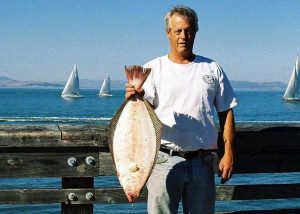
Striped bass are the trophy fish for most anglers and are common from the spring to the fall. Although some stripers are taken in the deep-water channel at the end of the pier, many are caught in the shallow waters along the shoreline. The favorite bait is a live shiner or a staghorn sculpin (bullhead) but pile worms and shrimp are not far behind. This is a good pier to try artificials for the stripers. Most locals use Fish Traps or Rebel Lures and best results are usually on an incoming tide. Give them a try.
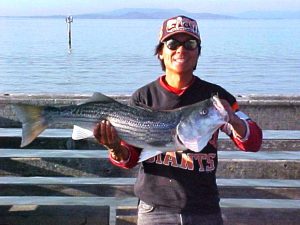
Striped Bass caught by “Stan The Man”
Most years will also see a few salmon taken during the fall months. These are almost always landed in the deep-water channel and most are caught using a frozen anchovy fished under a float. You can also try artificials for these but results are rarely hot. Steelhead are infrequently caught, but best bets to try are nightcrawlers fished under a bobber or float near the corners of the pier.
In late winter and spring months this can be a fairly good spot for sturgeon. If you decide to fish for these, and some are giants (including the reported catch of an 170-pound fish), make sure you are using heavy enough tackle and the right bait. Tackle should be suited for thirty pound or heavier test line, equipment should include wire sturgeon leaders equipped with two hooks, and bait should include grass, mud or ghost shrimp.
Unfortunately, one of the most common denizens of the deep lately has been Chinese mitten crabs. At times these bait stealers are as bad, or even worse, than the bullheads (staghorn sculpin) and both can make fishing almost impossible. Actually the fishing isn’t impossible, just the chance of catching anything. As soon as a bait hits the bottom a miniature Indy 500 begins with the crabs and bullheads revving their engines to see who can get to the bait first. It can be frustrating and more than one angler has simply given up and gone home. One alternative is to use artificial lures, another is to tie the hooks further up on the line so they are not as close to the bottom. Of course when the fish are on the bottom it’s hard not to concentrate on that area.
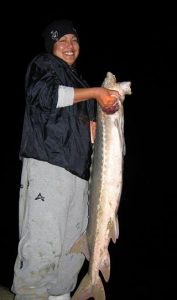
White Sturgeon
<*}}}}}}}}}>< — Some interesting data was supplied to me in 1994 by Peter Alexander who is the fisheries specialist for the East Bay Regional Park District and the writer of a bi-weekly newsletter called Anglers’ Edge. He has kept figures going back to 1986 on the Point Pinole Pier. His records show the following numerical ranking for fish caught at the pier. Most numerous are white croaker (kingfish), second are smelt (jacksmelt and topsmelt), third are sharks (several varieties), followed closely by perch. Next most common are striped bass, bat ray, starry flounder and sturgeon. Rounding out his figures are a few salmon and halibut.
He also shows a breakdown for the number of fish caught per month, although these figures need to be used with caution. To some extent these figures may simply reflect a greater number of anglers in the summer months and the type of fish the anglers are seeking. Nevertheless, the information is interesting. White croaker (kingfish) are caught year round with the highest numbers in April and May. The numbers for smelt are highest from July through October. Sharks are most common April to September and perch from August until April. Sturgeon have been caught every month of the year but the highest numbers are in March and April. As expected, the striped bass catch is greatest in the fall, starry flounder in late winter and early spring, and bat ray April through November.
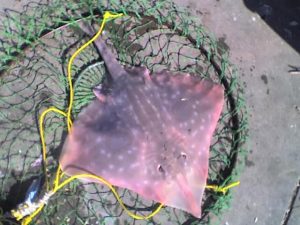
Skate
A second set of figures comes from fish surveys conducted by the California Department of Fish and Game from 2004 to 2009. Their results showed 18 different species ranked numerically — walleye surperch, white croaker, jacksmelt, striped bass, blackperch, starry flounder, calico surfperch, redtail surfperch, leopard shark, white sturgeon, bat ray, staghorn sculpin, California halibut, big skate, longnose skate, brown smoothhound shark, pile perch and shiner perch.
<*}}}}}}}}}>< — Special Bay Area Regulations:
- A perch closure exits in San Francisco and San Pablo Bay from April 1 to July 31. No perch may be kept other than shinerperch (20).
- In San Francisco and San Pablo Bay a fishing line may not contain more than three hooks.
Sturgeon Regulations:
- A sturgeon report card and tags are required for anyone fishing for or taking sturgeon. (a) The card must be in the angler’s possession; (b) a tag must be used for any sturgeon retained by the angler; (c) the angler must record information on the Sturgeon Report Card immediately after catching and keeping or releasing the sturgeon.
- White sturgeon can only be kept from 40-60 inches; larger and smaller sturgeon must be released.
- Green sturgeon may not be taken or possessed.
History Note. The word pinole is a Spanish word referring to a meal made of grain or seed used by the Indians in the area.
Between 1881 and 1960 a number of different companies manufactured gunpowder in this area. That fact and the need to keep the public a safe distance away (from possible explosions) led to a lack of development and the maintenance of a fairly pristine environment. An unintended consequence was its perfect setting for a park. When the land was purchased by Bethleham Steel in 1963 conservationists led the fight for a new park and the purchase by the East Bay Regional Park District in the early ’70s.
Further down the shoreline, near present day Pinole, wharves date back to the 1800s. In 1856, Bernardo Francisco created a warehouse and a trading port. In addition, he constructed two small wharves, one thirty feet in length and one twenty feet in length. The first wharf disappeared over time but the second was extended out several times. By 1882, the wharf had reached 2,300 feet in length but records state that the water depth was still only eight feet deep at the end, the same depth as when the wharf was only twenty feet long (believe it or not — Ripley, where are you?). The wharf is long gone; today the site is home to Pinole’s Bayfront Park.
Point Pinole Pier Facts —
With thanks to Glen G for the update
Hours: Park & Gate hours: 7 am – 7 pm.
Facilities: (1) There are two parking lots. The original one is at Giant Highway and the new one is at Atlas Road near the entrance to the park. If one is walking, the trail from the new lot is a flat grade all the way. But the old lot offers the prettiest hiking. The charge for the parking lot is $3.00 to park on weekends and holidays during the peak summertime season. If no one is manning the kiosk, the entrance fee is waived. (2) It is a long walk (about 1.5 miles) from the parking lot to the pier but some do it. More common and convenient is to use the park shuttle which runs on the half-hour daily, except for Tuesdays and Wednesdays, from the parking lot to the pier. Departures from the parking lot are hourly from 7:30 a.m. to 2:30 p.m. during much of the year, and generally the hours are extended during the summer months. The shuttle returns from the pier hourly from 8 a.m to 3 p.m. There is a $2.00 round trip fee for adults; 50 cents charge for those age 6-12. Senior citizens, age 62 and above, and disabled persons, ride free. The shuttle is often crowded on the last ride back to the parking lot so people may want to take the 2 P.M. shuttle to make sure they get a ride. Miss the 3 P.M. shuttle and you have to walk back. (3) Rest rooms are found near the front of the pier as are drinking fountains. Fish cleaning stations, benches and wind breaks are found on the pier. There are no bait and tackle or food facilities. Nearby are found shaded picnic areas and tables.
Handicapped Facilities: Handicapped parking and restrooms. All handicapped anglers need to use a shuttle to get to the pier. Not posted for handicapped.
How To Get There: From I80 take the Hilltop (Richmond) exit; go west on the Richmond Parkway to the exit for Giant Highway and a sign for Point Pinole Regional Park.
Management: East Bay Regional Parks District.
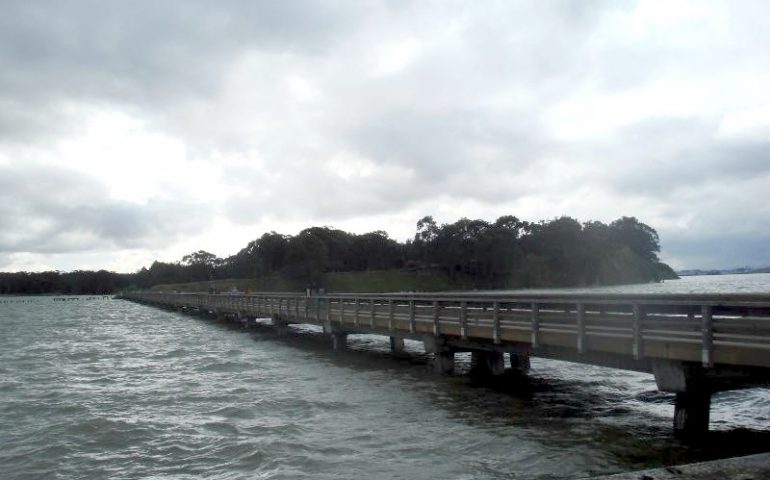
Hello is the pier open for fishing ?
How many rods can you use on the Point Pinole Pier?
Two.
Are you open nov and December 2020 and how many rods can be used